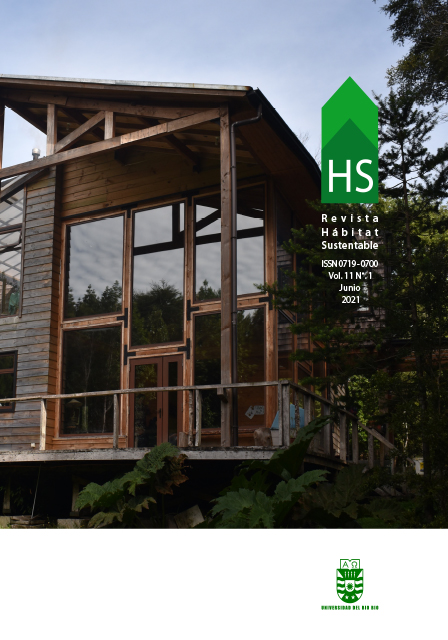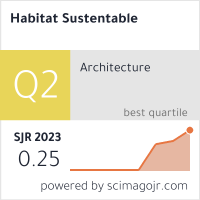Tuhouse: prototipo de vivienda social sostenible de alta densidad para el trópico
DOI:
https://doi.org/10.22320/07190700.2021.11.01.03Palabras clave:
vivienda social, prototipo, sostenibilidad, bioclimática, trópicoResumen
La presente contribución expone los resultados de la investigación desarrollada en el marco del concurso internacional Solar Decathlon LAC 2019, la cual tuvo por objetivo el diseño y construcción de un prototipo de vivienda económica TUHOUSE (Technically Unique House Using Solar Energy), a escala 1:1, capaz de incorporar estrategias sostenibles y bioclimáticas acordes con la región tropical. Para esto se llevó a cabo una metodología de taller de diseño, basada en el trabajo interdisciplinario entre distintas áreas de la Arquitectura y la Ingeniería, pertenecientes a diversos programas de las Universidades de San Buenaventura y Autónoma de Occidente (Cali, Colombia). El principal aporte metodológico fue lograr aquel trabajo interdisciplinario desde las etapas iniciales, lo cual se suma a que estudiantes y profesores participaran en la construcción del prototipo para finalmente verificar su comportamiento con las pruebas del concurso. Entre resultados de la experiencia, se destaca la propuesta urbana con alta habitabilidad y densidad, y la comprobación de estrategias pasivas de diseño enfocadas en la envolvente del prototipo, que pueden ser replicadas en condiciones similares, pero también la importancia del interrogante sobre la validez del modelo de confort térmico propuesto para regiones tropicales.
Descargas
Citas
ASHRAE/ANSI (2017). Standard 55–2017: Thermal Environmental Conditions for Human Occupancy. Pub. L. No. 55-2017, ASHRAE.
ASRHAE (2005). Thermal Comfort. En ASHRAE Handbook—Fundamentals.
AULICIEMS, A. (1975). Warmth and comfort in the subtropical winter: A study in Brisbane schools. Journal of Hygiene, 74(3), 339-343. DOI: https://doi.org/10.1017/S0022172400046854
BAUMBER, A., KLIGYTE, G., BIJL-BROUWER, M. VAN DER Y PRATT, S. (2020). Learning together: a transdisciplinary approach to student–staff partnerships in higher education. Higher Education Research & Development, 39(3), 395-410.
BECKER, R., GOLDBERGER, I. Y PACIUK, M. (2007). Improving energy performance of school buildings while ensuring indoor air quality ventilation. Building and Environment, 42(9), 3261-3276. DOI:10.1016/j.buildenv.2006.08.016
BEDOYA, C. Y DZUL, L. (2015). El concreto con agregados reciclados como proyecto de sostenibilidad urbana. Revista Ingenieria de Construccion, 30(2), 99-108. DOI: https://doi.org/10.4067/s0718-50732015000200002
COBO, C., VILLALOBOS, M. Y MONTOYA, O. L. (2019). Sustainable architecture and engineering MIHOUSE project. Santiago de Cali: Editorial Bonaventuriana & Universidad Autónoma de Occidente.
EVANS, J. M. Y SCHILLER, S. D. (1994). Diseño bioambiental y arquitectura solar. Buenos Aires: Universidad de Buenos Aires.
FANGER, P. O. (1972). Thermal comfort. Analysis and applications in environmental engineering. New York: McGraw-Hill.
FANGER, P. O. Y TOFTUM, J. (2002). Extension of the PMV model to non-air-conditioned buildings in warm climates. Energy and Buildings, 34(6), 533-536. DOI: https://doi.org/10.1016/S0378-7788(02)00003-8
GAMBOA, J. D., ROSILLO, M. E., HERRERA, C. A., LÓPEZ, O. Y IGLESIAS, V. (2011). Confort Ambiental en vivienda de interés social en Cali. Santiago de Cali: Universidad del Valle.
GIRALDO, W., CZAJKOWSKI, J. D. Y GÓMEZ, A. F. (2020). Confort térmico en vivienda social multifamiliar de clima cálido en Colombia. Revista de Arquitectura (Bogotá), 23(1).
HERRERA, C. A. Y ROSILLO, M. (2019). Confort y eficiencia energética en el diseño de edificaciones: un enfoque práctico. Santiago de Cali: Universidad del Valle.
HERRERA, R., PINEDA, P., ROA, J., CORDERO, S. Y LÓPEZ, Á. (2017). Proyecto Aura: vivienda social sostenible. En 3er Congreso Internacional de Construcción Sostenible y Soluciones Eco-Eficientes (pp. 686-697). Recuperado de https://idus.us.es/handle/11441/59216. Universidad de Sevilla, Escuela Técnica Superior de Arquitectura.
HERRERA, R., REY, J., HERNÁNDEZ, M. Y ROA, J. (2020). Student competitions as a learning method with a sustainable focus in higher education: The University of Seville «Aura Projects» in the «Solar Decathlon 2019». Sustainability (Switzerland), 12(4). DOI: https://doi.org/10.3390/su12041634
INSTITUTO COLOMBIANO DE NORMAS TÉCNICAS Y CERTIFICACIÓN -ICONTEC (2004). Norma Técnica Colombiana NTC 5316. Thermal environmental conditions for human occupancy.
IRAM 11601 (2004). Aislamiento Térmico para edificios. Argentina. Recuperado de http://materias.fi.uba.ar/6731/Tablas/Tabla6.pdf
KONYA, A. (1980). Design primer for hot climates. London: The Architectural Press Ltda.
López, Y. U. y Holguín, J. E. (Eds.). (2020). Water and Energy Engineering for Sustainable Buildings Mihouse Project. Santiago de Cali: Editorial Universidad Autónoma de Occidente.
MACÍAS, H. (2020). Reporte final, grupo de energías equipo TUHOUSE. Santiago de Cali.
MONTOYA, O. L. (2014). Habitabilidad en los conjuntos multifamiliares de interés social construidos en Cali entre 1990 y 2010. Santiago de Cali: Editorial Bonaventuriana
MONTOYA, O. L. (2020). La arquitectura del aula para el trópico. Principios de diseño pasivo para edificaciones eficientes. Tesis de doctorado. Universidad Nacional de La Plata, Argentina.
NICOL, F., HUMPHREYS, M. Y ROAF, S. (2012). Adaptive thermal comfort: principles and practice. Londres: Routledge.
OLGYAY, V. (1963). Clima y Arquitectura en Colombia. Barcelona: Gustavo Gili.
SAMPER, G. (2002). Recinto urbano: la humanización de la ciudad. Bogotá: Fondo Editorial Escala.
SAMPER, G. (2003). La evolución de la vivienda. Bogotá: Colección Somos Sur.
SAN JUAN, G., ROSENFELD, E., SANTINELLI, G., DISCOLL, C., VIEGAS, G., BREA, B., … ROJAS, D. (2013). Diseño bioclimático como aporte al proyecto arquitectónico. La Plata: Universidad de La Plata.
SANCHEZ, J. A. (2019). De la cubierta urbana al prototipo. Proceso evolutivo para el concurso Solar Decathlon Latinoamérica y el Caribe 2019. Sevilla. Recuperado de https://idus.us.es/bitstream/handle/11441/89634/Q%20AO%20Tfg%20ETSA%20253.pdf?sequence=1
SOLAR DECATHLON (2019). Final rules. Solar Decathlon para América Latina y el Caribe. Colombia.
TERRADOS, F., BACO, L. Y MORENO, D. (2015). Patio 2.12: Vivienda prefabricada, sostenible, autosuficiente y energéticamente eficiente . Participación en la competición Solar Decathlon Europe 2012. Informes de la Construcción, 67(538), 1-11.
UNIDAD DE PLANEACIÓN MINERO ENERGÉTICA -UPME (2018). Boletín estadístico de minas y energía. Recuperado de http://www1.upme.gov.co/PromocionSector/SeccionesInteres/Documents/Boletines/Boletin_Estadistico_2018.pdf
UNIDAD DE PLANEACIÓN MINERO ENERGÉTICA -UPME (2019). Plan energético nacional 2020-2050. Recuperado de https://www1.upme.gov.co/DemandaEnergetica/PEN_documento_para_consulta.pdf#search=consumo energia sector residencial
VAN DER VEGT, A. Y GOVAERT, L. E. (2005). Polymeren, van keten tot kunststof. Amsterdam: VSSD.
ZAPATA, C. M., VIEGAS, G. M., SAN JUAN, G. A., RAMOS, H., CORONADO, J. A., OCHOA, J., …, Y MONTOYA, O. L. (2018). Comodidad ambiental en aulas escolares. Incidencia en la salud docente y en el rendimiento cognitivo de los estudiantes en colegios públicos de Bogotá, Medellín y Cali. Santiago de Cali: Editorial Bonaventuriana, Ediciones Unisalle, Universidad Nacional de la Plata. Recuperado de http://www.editorialbonaventuriana.usb.edu.co/libros/2018/comodidad-ambiental-aulas/index.html
Descargas
Publicado
Cómo citar
Número
Sección
Licencia
Derechos de autor 2021 Constanza Cobo-Fray, Olga Lucia Montoya-Flórez

Esta obra está bajo una licencia internacional Creative Commons Atribución-CompartirIgual 4.0.
El contenido de los artículos que se publican en cada número de Hábitat Sustentable, es responsabilidad exclusiva de los autores y no representan necesariamente el pensamiento ni comprometen la opinión de la Universidad del Bío-Bío.
Los autores/as conservarán sus derechos de autor y garantizarán a la revista el derecho de primera publicación de su obra, el cuál estará simultáneamente sujeto a la Licencia de Reconocimiento de Creative Commons CC BY-SA que permite a otros compartir-copiar, transformar o crear nuevo material a partir de esta obra con fines no comerciales, siempre y cuando se reconozcan la autoría y la primera publicación en esta revista, y sus nuevas creaciones estén bajo una licencia con los mismos términos.











 Programa de Información Científica/Concurso Fondos de Publicación de Revistas Científicas 2018/ Proyecto Mejoramiento de Visibilidad de Revistas UBB (Código:FP180007)
Programa de Información Científica/Concurso Fondos de Publicación de Revistas Científicas 2018/ Proyecto Mejoramiento de Visibilidad de Revistas UBB (Código:FP180007) 





